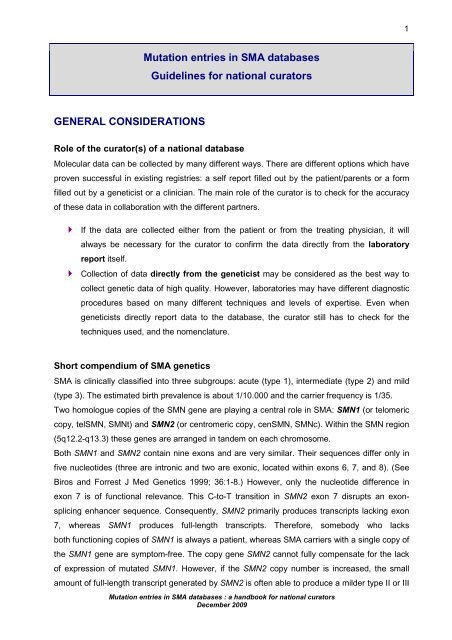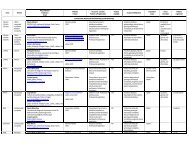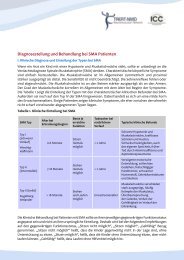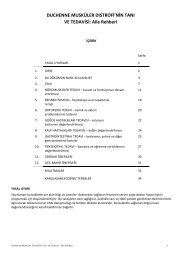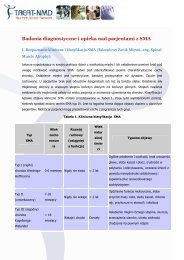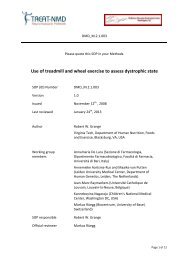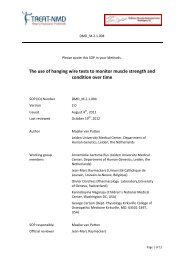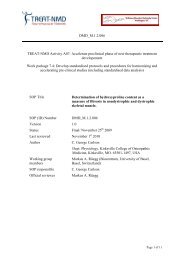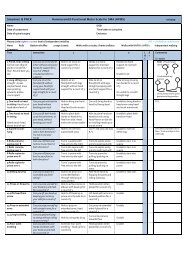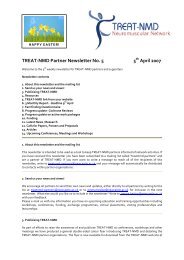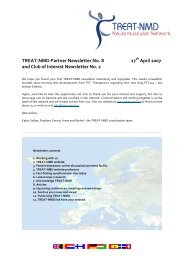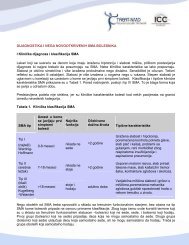A handbook on SMA genetics - Treat-NMD
A handbook on SMA genetics - Treat-NMD
A handbook on SMA genetics - Treat-NMD
You also want an ePaper? Increase the reach of your titles
YUMPU automatically turns print PDFs into web optimized ePapers that Google loves.
1<br />
Mutati<strong>on</strong> entries in <strong>SMA</strong> databases<br />
Guidelines for nati<strong>on</strong>al curators<br />
GENERAL CONSIDERATIONS<br />
Role of the curator(s) of a nati<strong>on</strong>al database<br />
Molecular data can be collected by many different ways. There are different opti<strong>on</strong>s which have<br />
proven successful in existing registries: a self report filled out by the patient/parents or a form<br />
filled out by a geneticist or a clinician. The main role of the curator is to check for the accuracy<br />
of these data in collaborati<strong>on</strong> with the different partners.<br />
If the data are collected either from the patient or from the treating physician, it will<br />
always be necessary for the curator to c<strong>on</strong>firm the data directly from the laboratory<br />
report itself.<br />
Collecti<strong>on</strong> of data directly from the geneticist may be c<strong>on</strong>sidered as the best way to<br />
collect genetic data of high quality. However, laboratories may have different diagnostic<br />
procedures based <strong>on</strong> many different techniques and levels of expertise. Even when<br />
geneticists directly report data to the database, the curator still has to check for the<br />
techniques used, and the nomenclature.<br />
Short compendium of <strong>SMA</strong> <strong>genetics</strong><br />
<strong>SMA</strong> is clinically classified into three subgroups: acute (type 1), intermediate (type 2) and mild<br />
(type 3). The estimated birth prevalence is about 1/10.000 and the carrier frequency is 1/35.<br />
Two homologue copies of the SMN gene are playing a central role in <strong>SMA</strong>: SMN1 (or telomeric<br />
copy, telSMN, SMNt) and SMN2 (or centromeric copy, cenSMN, SMNc). Within the SMN regi<strong>on</strong><br />
(5q12.2-q13.3) these genes are arranged in tandem <strong>on</strong> each chromosome.<br />
Both SMN1 and SMN2 c<strong>on</strong>tain nine ex<strong>on</strong>s and are very similar. Their sequences differ <strong>on</strong>ly in<br />
five nucleotides (three are intr<strong>on</strong>ic and two are ex<strong>on</strong>ic, located within ex<strong>on</strong>s 6, 7, and 8). (See<br />
Biros and Forrest J Med Genetics 1999; 36:1-8.) However, <strong>on</strong>ly the nucleotide difference in<br />
ex<strong>on</strong> 7 is of functi<strong>on</strong>al relevance. This C-to-T transiti<strong>on</strong> in SMN2 ex<strong>on</strong> 7 disrupts an ex<strong>on</strong>splicing<br />
enhancer sequence. C<strong>on</strong>sequently, SMN2 primarily produces transcripts lacking ex<strong>on</strong><br />
7, whereas SMN1 produces full-length transcripts. Therefore, somebody who lacks<br />
both functi<strong>on</strong>ing copies of SMN1 is always a patient, whereas <strong>SMA</strong> carriers with a single copy of<br />
the SMN1 gene are symptom-free. The copy gene SMN2 cannot fully compensate for the lack<br />
of expressi<strong>on</strong> of mutated SMN1. However, if the SMN2 copy number is increased, the small<br />
amount of full-length transcript generated by SMN2 is often able to produce a milder type II or III<br />
Mutati<strong>on</strong> entries in <strong>SMA</strong> databases : a <str<strong>on</strong>g>handbook</str<strong>on</strong>g> for nati<strong>on</strong>al curators<br />
December 2009
phenotype. In c<strong>on</strong>clusi<strong>on</strong>, the more SMN2 copies a patient has, the less severe the disease is<br />
expected to be.<br />
2<br />
A few things to keep in mind<br />
Approximately 95-98% of patients with the clinical diagnosis of <strong>SMA</strong> lack both copies<br />
(homozygous deleti<strong>on</strong>) of SMN1 ex<strong>on</strong> 7 (and ex<strong>on</strong> 8 in the majority of cases).<br />
As described above, the most comm<strong>on</strong> genetic result leading to the diagnosis of <strong>SMA</strong> is<br />
a homozygous deleti<strong>on</strong> of SMN1 ex<strong>on</strong> 7 (and ex<strong>on</strong> 8). This is different in <strong>on</strong>ly a minority<br />
of <strong>SMA</strong> patients (2-5%): these patients are compound heterozygous, e.g. carry an<br />
SMN1 deleti<strong>on</strong> of ex<strong>on</strong> 7 (and ex<strong>on</strong> 8) <strong>on</strong> <strong>on</strong>e of their alleles and an intragenic<br />
point mutati<strong>on</strong> of the SMN1 gene <strong>on</strong> the other allele. Point mutati<strong>on</strong>s may be<br />
dispersed all over the SMN1 gene.<br />
The most up-to-date diagnostic techniques for <strong>SMA</strong> deleti<strong>on</strong> analysis are quantitative<br />
techniques like Real-Time PCR (TaqMan, SybrGreen I, FRET) or, most comm<strong>on</strong>ly used,<br />
MLPA. For an accurate genetic diagnosis and inclusi<strong>on</strong> into the registry, results of n<strong>on</strong>quantitative<br />
methods (PCR-RFLP analysis) should be c<strong>on</strong>firmed by a quantitative<br />
analysis.<br />
In order to detect point mutati<strong>on</strong>s, the SMN1-gene has to be sequenced. Sequence<br />
analysis of all SMN1 ex<strong>on</strong>s and intr<strong>on</strong>/ex<strong>on</strong> borders may be used to identify the<br />
intragenic SMN1 point mutati<strong>on</strong>s. Ex<strong>on</strong>ic regi<strong>on</strong>s must be individually amplified;<br />
therefore, sequence analysis does not detect ex<strong>on</strong>ic deleti<strong>on</strong>s or duplicati<strong>on</strong>s.<br />
In rare cases, instead of the point mutati<strong>on</strong> there may be a c<strong>on</strong>versi<strong>on</strong> mutati<strong>on</strong><br />
from SMN1 to SMN2 of <strong>on</strong>e copy of the gene (ex<strong>on</strong>s 7 and 8), if it affects nucleotide<br />
positi<strong>on</strong> 873 in ex<strong>on</strong> 7 (c.873C>T). Together with a heterozygous deleti<strong>on</strong> of SMN1<br />
ex<strong>on</strong> 7, these patients appear to be homozygously deleted for SMN1 ex<strong>on</strong> 7, if the test<br />
method is based <strong>on</strong> the single nucleotide difference in ex<strong>on</strong> 7 <strong>on</strong>ly.<br />
The SMN2 copy number is an additi<strong>on</strong>al item which can be entered into the database.<br />
However, this genetic item cannot be detected by all methods that are used routinely.<br />
Since this item might be of interest regarding the predicti<strong>on</strong> of phenotype and<br />
possibilities for therapeutic interventi<strong>on</strong>, quantitative analysis including the SMN2 copy<br />
number is str<strong>on</strong>gly encouraged.<br />
Each genotyped patient will corresp<strong>on</strong>d to <strong>on</strong>e record in the database. So even within a<br />
family, each affected individual should have been genotyped to be entered in the<br />
database. (Even if it is rare, the occurrence of independent mutati<strong>on</strong>s within a family<br />
has already been described).<br />
Only accurately defined mutati<strong>on</strong>s are suitable for inclusi<strong>on</strong> in a database.<br />
Mutati<strong>on</strong> entries in <strong>SMA</strong> databases : a <str<strong>on</strong>g>handbook</str<strong>on</strong>g> for nati<strong>on</strong>al curators<br />
December 2009
3<br />
Report of <strong>SMA</strong> genetic results<br />
First step: identify the method used for genetic testing<br />
A: Quantitative methods (MLPA, Real-Time PCR)<br />
MLPA (Multiplex Ligand-dependent Probe Amplificati<strong>on</strong>) and Taq man/Real-time PCR are<br />
quantitative methods used to detect ex<strong>on</strong> 7 deleti<strong>on</strong>s in the SMN1 gene and to analyze the<br />
SMN2 copy number.<br />
Possible results are:<br />
homozygous deleti<strong>on</strong> of ex<strong>on</strong> 7 (and ex<strong>on</strong> 8) of SMN1: diagnostic criteria fulfilled,<br />
patient can be entered into database<br />
homozygous deleti<strong>on</strong> of ex<strong>on</strong> 7 and heterozygous deleti<strong>on</strong> of ex<strong>on</strong> 8 of SMN1:<br />
diagnostic criteria fulfilled, patient can be entered into database (this can mean a<br />
c<strong>on</strong>versi<strong>on</strong> mutati<strong>on</strong> from SMN1 to SMN2 of <strong>on</strong>e copy of the whole gene!)<br />
heterozygous deleti<strong>on</strong> of ex<strong>on</strong> 7 (and ex<strong>on</strong> 8) of SMN1:<br />
o<br />
o<br />
patient is carrier or<br />
sequence analysis identified compound heterozygous point mutati<strong>on</strong> in SMN1<br />
in c<strong>on</strong>sanguineous families, the occurrence of the same point mutati<strong>on</strong> <strong>on</strong> both<br />
alleles of the SMN1 gene in the patient might be c<strong>on</strong>sidered<br />
compound heterozygous for two different point mutati<strong>on</strong>s in SMN1 (not reported)<br />
evaluati<strong>on</strong> of SMN2 copy number is possible, but not always given in the genetic report<br />
B: RFLP<br />
RFLP (Restricti<strong>on</strong>-fragment length polymorphism) is a qualitative assay to detect the<br />
homozygous absence of SMN1 by taking advantage of the nucleotide difference between SMN1<br />
and SMN2 in ex<strong>on</strong> 7 (and ex<strong>on</strong> 8).<br />
homozygous deleti<strong>on</strong> of ex<strong>on</strong> 7 (and ex<strong>on</strong> 8) of SMN1: diagnostic criteria fulfilled,<br />
patient can be entered into database<br />
Qualitative RFLP analysis cannot distinguish carriers of <strong>on</strong>e SMN1 copy from individuals<br />
with two copies. The SMN2 copy number cannot be detected by this method.<br />
C: Linkage analysis<br />
Linkage analysis is available for families if direct DNA testing is not sufficiently informative. It<br />
may be used for c<strong>on</strong>firmati<strong>on</strong> of carrier testing and prenatal testing results.<br />
The detecti<strong>on</strong> of the SMN2 copy number is not possible with this method.<br />
If <strong>on</strong>ly a linkage analysis is used, patients should be c<strong>on</strong>tacted and encouraged to<br />
provide/obtain a direct <strong>SMA</strong> testing result.<br />
Mutati<strong>on</strong> entries in <strong>SMA</strong> databases : a <str<strong>on</strong>g>handbook</str<strong>on</strong>g> for nati<strong>on</strong>al curators<br />
December 2009
4<br />
D: Sequence analysis<br />
Sequence analysis is not offered routinely and can <strong>on</strong>ly be performed in some laboratories. This<br />
method is used if a patient has been diagnosed with a heterozygous deleti<strong>on</strong> of SMN1 <strong>on</strong> <strong>on</strong>e<br />
allele in order to detect a compound heterozygous point mutati<strong>on</strong> <strong>on</strong> the sec<strong>on</strong>d allele.<br />
Point mutati<strong>on</strong>s are found in 2-5% of patients with <strong>SMA</strong>. These include substituti<strong>on</strong>s (mainly<br />
n<strong>on</strong>sense mutati<strong>on</strong>s and missense mutati<strong>on</strong>s); deleti<strong>on</strong>s or inserti<strong>on</strong>s of a small number of<br />
nucleotides (frameshifting mutati<strong>on</strong>s); and splice site mutati<strong>on</strong>s.<br />
To avoid err<strong>on</strong>eous reports and to be unequivocal, it is essential:<br />
to use the standard reference sequence:<br />
the standard reference sequence for SMN1 (MIM No. 600354) is NM_000344.3<br />
(gi:196115055).<br />
to follow the internati<strong>on</strong>al mutati<strong>on</strong> nomenclature.<br />
to collect exhaustive data: the name of the mutati<strong>on</strong> at the DNA level and at the protein<br />
level; the correct ex<strong>on</strong>/intr<strong>on</strong> number, etc.<br />
Sequence analysis cannot determine whether a point mutati<strong>on</strong> is in the SMN1 gene or in the<br />
SMN2 gene, unless <strong>on</strong>e of these genes is absent. Therefore, finding a mutati<strong>on</strong> does not<br />
automatically mean that the mutati<strong>on</strong> is in SMN1. However, several point mutati<strong>on</strong>s have<br />
meanwhile been described. Identificati<strong>on</strong> of a previously reported point mutati<strong>on</strong> provides<br />
evidence that the mutati<strong>on</strong> is in SMN1.<br />
For c<strong>on</strong>firmati<strong>on</strong> that the SMN1 gene harbours the pathogenic mutati<strong>on</strong>, the two genes can be<br />
distinguished by cl<strong>on</strong>ing experiments prior to sequencing. Alternatively, SMN1 can specifically<br />
be amplified by l<strong>on</strong>g-range PCR prior to nested internal PCR and sequencing.<br />
A list of SMN1 mutati<strong>on</strong>s can, for example, be found in “Molecular and Functi<strong>on</strong>al Analysis of<br />
Intragenic SMN1 Mutati<strong>on</strong>s in Patients with Spinal Muscular Atrophy” by Sun et al, Human<br />
Mutati<strong>on</strong> 2005;25:64-71.<br />
Possible reas<strong>on</strong>s if a sequence alterati<strong>on</strong> is not detected:<br />
Patient does not have a mutati<strong>on</strong> in the tested gene (e.g., a sequence alterati<strong>on</strong> exists in<br />
another gene at another locus).<br />
Patient has a sequence alterati<strong>on</strong> that cannot be detected by sequence analysis (e.g., a<br />
large deleti<strong>on</strong>, a splice site deleti<strong>on</strong>). Large deleti<strong>on</strong>s or possible duplicati<strong>on</strong>s should be<br />
detected by l<strong>on</strong>g-range PCR.<br />
Patient has a sequence alterati<strong>on</strong> in a regi<strong>on</strong> of the gene (e.g., an intr<strong>on</strong> or regulatory<br />
regi<strong>on</strong>) not covered by the laboratory's test.<br />
Mutati<strong>on</strong> entries in <strong>SMA</strong> databases : a <str<strong>on</strong>g>handbook</str<strong>on</strong>g> for nati<strong>on</strong>al curators<br />
December 2009
5<br />
General rules for <strong>SMA</strong> genetic reports<br />
1) Identify the technique used. Is it a quantitative or qualitative technique? Although<br />
quantitative techniques are c<strong>on</strong>sidered state-of-the-art, also results of PCR-RFLP<br />
should be accepted, since not all labs perform quantitative testing.<br />
However, each mutati<strong>on</strong> should be validated by two methods (e.g., PCR-RFLP,<br />
Real-Time PCR, or MLPA)<br />
2) Determine if the diagnostic criteria for <strong>SMA</strong> have been fulfilled. One of the following<br />
opti<strong>on</strong>s has to be the case:<br />
a. homozygous deleti<strong>on</strong> of ex<strong>on</strong> 7 (and ex<strong>on</strong> 8) in SMN1<br />
b. heterozygous deleti<strong>on</strong> of ex<strong>on</strong> 7 (and ex<strong>on</strong> 8) in SMN1 compound heterozygous<br />
to a point mutati<strong>on</strong> in SMN1<br />
c. homozygous deleti<strong>on</strong> of ex<strong>on</strong> 7 in SMN1 and heterozygous deleti<strong>on</strong> of ex<strong>on</strong> 8 in SMN1<br />
d. homozygous for <strong>on</strong>e point mutati<strong>on</strong> in SMN1 (very rare, in c<strong>on</strong>sanguineous families)<br />
e. compound heterozygous for two point mutati<strong>on</strong>s in SMN1 (not yet been reported)<br />
3) Report the ex<strong>on</strong> deleti<strong>on</strong> result of the genetic testing <strong>on</strong> the cDNA level according to<br />
the reference sequence:<br />
a. deleti<strong>on</strong> of ex<strong>on</strong> 7: c.724_834del<br />
b. deleti<strong>on</strong> of ex<strong>on</strong>s 7 and 8: c.724_885del<br />
Mutati<strong>on</strong> entries in <strong>SMA</strong> databases : a <str<strong>on</strong>g>handbook</str<strong>on</strong>g> for nati<strong>on</strong>al curators<br />
December 2009
6<br />
Sec<strong>on</strong>d step: describe the point mutati<strong>on</strong> (see www.hgvs.org)<br />
Indicate the level of descripti<strong>on</strong> of the mutati<strong>on</strong>:<br />
c. coding sequence<br />
g. genomic DNA<br />
r. RNA<br />
p. protein: use the three-letter amino-acid code<br />
Use the correct symbols:<br />
">" for substituti<strong>on</strong>s.<br />
Ex: c.815C>T, denotes a change of a cytosine to a thymidine at nucleotide positi<strong>on</strong> 815 in<br />
ex<strong>on</strong> 6 and corresp<strong>on</strong>ds to p.Y272C <strong>on</strong> the protein level<br />
"_" for small deleti<strong>on</strong>s, duplicati<strong>on</strong>s or inserti<strong>on</strong>s.<br />
Ex: c.558_559del or c.558_559delA, denotes a deleti<strong>on</strong> of A from nucleotide 558 to 559.<br />
Ex: c.558_559dup or c.558_559dupA, denotes a duplicati<strong>on</strong> of the nucleotide A 558 to 559.<br />
Ex: c.208_209insA, denotes an inserti<strong>on</strong> of <strong>on</strong>e nucleotide (A) between nucleotide 208 and<br />
209.<br />
"+" and "-" for intr<strong>on</strong>ic mutati<strong>on</strong>s.<br />
The current recommendati<strong>on</strong>s for the descripti<strong>on</strong> of intr<strong>on</strong>ic mutati<strong>on</strong>s suggest identifying<br />
them relative to the coding DNA reference sequence (c.889+6T>G or c.1603-…) rather than<br />
relative to the intr<strong>on</strong> number (IVS3+… or IVS14-…). The coding DNA reference sequence<br />
positi<strong>on</strong> used is either the first or last nucleotide of a given ex<strong>on</strong>, as follows:<br />
"+": Beginning of the intr<strong>on</strong>: the number of the last nucleotide of the preceding ex<strong>on</strong>, a plus<br />
sign and the positi<strong>on</strong> in the intr<strong>on</strong>.<br />
"-": End of the intr<strong>on</strong>: the number of the first nucleotide of the following ex<strong>on</strong>, a minus sign<br />
and the positi<strong>on</strong> in the intr<strong>on</strong>.<br />
Validate the mutati<strong>on</strong>:<br />
Some validati<strong>on</strong> steps should be d<strong>on</strong>e before c<strong>on</strong>sidering a change in amino acid as the<br />
disease-causing mutati<strong>on</strong>:<br />
Has the entire coding regi<strong>on</strong> been sequenced for mutati<strong>on</strong>s?<br />
What was the technique used? Specifically, was direct sequencing performed, or were<br />
scanning methods used (such as DHPLC, SSCP, or other methods)?<br />
What is the impact <strong>on</strong> the structure/functi<strong>on</strong> of the protein?<br />
Epidemiological studies: what is the frequency of the sequence variati<strong>on</strong> in at least 200<br />
chromosomes?<br />
Is the sequence alterati<strong>on</strong> reported as a polymorphism in internati<strong>on</strong>al databases?<br />
Is it a de novo mutati<strong>on</strong>?<br />
Mutati<strong>on</strong> entries in <strong>SMA</strong> databases : a <str<strong>on</strong>g>handbook</str<strong>on</strong>g> for nati<strong>on</strong>al curators<br />
December 2009
7<br />
1. Identify the technique used.<br />
2. Identify the exact ex<strong>on</strong>s tested.<br />
Rules for point mutati<strong>on</strong>s<br />
a. Was the entire gene directly sequenced, or screened by another<br />
technique?<br />
b. Was the entire gene sequenced, or just <strong>on</strong>e ex<strong>on</strong>?<br />
3. Collect all available data:<br />
a. Mutati<strong>on</strong> class (n<strong>on</strong>sense; missense; frameshift inserti<strong>on</strong>, deleti<strong>on</strong> or<br />
inserti<strong>on</strong>/deleti<strong>on</strong>; splice site)<br />
b. Ex<strong>on</strong> or intr<strong>on</strong> number<br />
c. Nucleotide positi<strong>on</strong> (DNA level)<br />
d. Amino acid positi<strong>on</strong> (protein level)<br />
4. C<strong>on</strong>firm the correct mutati<strong>on</strong> nomenclature using Internati<strong>on</strong>al Mutati<strong>on</strong><br />
Nomenclature<br />
5. Determine if the mutati<strong>on</strong> has already been described in the literature<br />
6. Determine if the testing was c<strong>on</strong>clusive. Check each of the following. Testing<br />
was not c<strong>on</strong>clusive if the answer to any of the following is “No”:<br />
a. For missense mutati<strong>on</strong>s:<br />
i. Was the entire coding regi<strong>on</strong> sequenced?<br />
ii. Was a quantitative test performed to exclude a homozygous<br />
deleti<strong>on</strong>?<br />
b. For splice site mutati<strong>on</strong>s:<br />
i. Was the mutati<strong>on</strong> at a locati<strong>on</strong> already known to affect splicing?<br />
ii. If not, was transcript analysis performed to c<strong>on</strong>firm the effect of<br />
the putative mutati<strong>on</strong> <strong>on</strong> splicing?<br />
Mutati<strong>on</strong> entries in <strong>SMA</strong> databases : a <str<strong>on</strong>g>handbook</str<strong>on</strong>g> for nati<strong>on</strong>al curators<br />
December 2009


